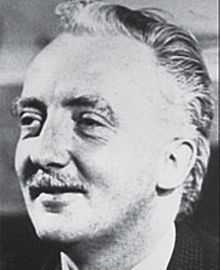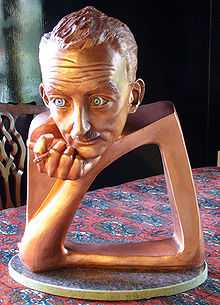Seán Ó Riada
| Seán Ó Riada | |
|---|---|
 | |
| Background information | |
| Birth name | John Reidy |
| Born | 1 August 1931 |
| Origin | Cork, Ireland |
| Died |
3 October 1971 (aged 40) London, England |
| Occupations | Composer |
Seán Ó Riada (1 August 1931 – 3 October 1971), was a composer and perhaps the single most influential figure in the revival of Irish traditional music during the 1960s. He became a household figure in Ireland through his participation in Ceoltóirí Chualann, compositions, writings and broadcasts on the topic.
Early life

Born John Reidy in Cork City,[1] he was educated at St Finbarr's College, Farranferris. He then transferred to St Munchin's College in Limerick where he completed his Leaving Certificate in 1948. He played the violin, piano and organ and studied the Greek and Latin classics at University College Cork, studying with Aloys Fleischman and graduating in 1952. While at College, Ó Riada was the auditor of the UCC Philosophical Society. In the same year he became assistant director for Radio Éireann. He married Ruth Coughlan in 1953. During the evening he played piano with dance bands. In 1955 Ó Riada moved to France and continued his work in radio, returning to Ireland in 1957. During the late fifties he composed a number of orchestral and piano pieces in the style of serialism, including "Nomos," which received a mixed critical reception.
Mise Éire
Ó Riada also composed and directed classical music for theatre and film, combining traditional Irish tunes and "sean-nós" (old style) songs with the classical orchestral tradition, similar to noted nationalist composers such as Dvořák (Czeck), Bartók (Hungarian) and Ralph Vaughan Williams (English). In 1957, he became musical director of the Abbey Theater in Dublin. In 1958 an Irish radio station in Cork commissioned a short work. In 1959 he scored a documentary film by George Morrison called Mise Éire (I am Ireland). It is about the founding of the Republic of Ireland. It has repeatedly been used in other documentaries and is available on CD, together with other film music – "Saoirse" (1960) and An Tine Bheo (The Living Fire). The recording is conducted by Ó Riada himself. These works Mise Éire brought him national acclaim and allowed him to start a series of programmes on Irish radio called Our Musical Heritage. Ó Riada told people that one should listen to sean-nós song either as a child would listen or as if they were songs from India.
Ceoltóirí Chualann
Between 1961 and 1969 Ó Riada was leader of a group called Ceoltóirí Chualann. Although they played in concert halls dressed in black suits with white shirts and black bow ties, they played traditional songs and tunes. An ordinary céilidh band or show-band would have musicians who competed with each other to grab the attention of the audience. Ceoltóirí Chualann played sparse lucid arrangements. Ó Riada sat in the middle at front playing bodhrán, a hand-held frame-drum. This was an instrument that had almost died out, being played only by small boys in street parades. Ceilí bands generally had jazz-band drum-kits. Ó Riada also wanted to use the clarsach or wire-strung harp in the band, but as these were as yet unavailable, he played the harpsichord instead – the nearest sound to a clarsach. The harpsichord he used on a regular basis was made by Cathal Gannon. Unknown to Ó Riada, Irish folk music was being played ensemble-style in London pubs, but for most people of Ireland this was the first time they heard these tunes played by a band. The membership of Ceoltóirí Chualann overlapped with membership of The Chieftains, so it is surprising that the six albums they recorded are not better known. They recorded the soundtrack of the film "Playboy of the Western World" (original play by John Millington Synge) in 1963. Their last public performance was in 1969, and issued as the album "Ó Riada Sa Gaiety".
Final years
In 1964 Ó Riada moved to Cúil Aodha in West Cork, an Irish-speaking area. He established Cór Chúil Aodha, a male voice choir. He turned toward church choral music, including "Aifreann 2" (premiered posthumously in 1979). Other works include "Five Greek Epigrams" and "Holdlerin Songs." In 1996 Kate Bush recorded the Peadar Ó Doirnín lyric "Mná na hÉireann," set to music by Sean Ó Riada and Ceoltóirí Chualann, for the compilation album "Common Ground." "Mná na hÉireann," as performed by the Chieftains, is used as a romantic overture throughout the Stanley Kubrick movie Barry Lyndon and is the basis of The Christians' 1989 single "Words". Ó Riada did a setting of the poetry of Thomas Kinsella, who returned the favour by praising Ó Riada in verse. He became involved in Irish politics and was a friend of several influential leaders[citation needed]. Ó Riada and Ruth both drank regularly at a local pub which still advertises itself as his being his local. He suffered cirrhosis of the liver. He was flown to King's College Hospital, London for treatment and died there. He is buried in St Gobnait's graveyard, Baile Bhuirne, County Cork. Willie Clancy played at his funeral.
Two schools are named 'Scoil Uí Riada' after him: a Gaelscoil in Kilcock, Co. Kildare, and another, in Bishopstown, Cork City.
Commemorating Ó Riada

In 2008, a life-sized statue was erected in the grounds of Sépéil Naomh Gobnait, Cúil Aodha.
On 23 April 2010 Ceoltoiri Chualann reformed under the leadership of Peadar Ó Riada to play a tribute concert to Sean Ó Riada in Dublin's Liberty Hall.

In 2011, A festival, Féile na Laoch, was organised in his honour by his son, Peadar, between 30 September and 3 October in the honour of heroes (laochra) from the seven 'Muses': Storytelling, Sport, Singing, Poetry, Music, Dancing and Acting centring around Ó Riada.
Footnotes
References
- Kinsella, Thomas & Ó Cannain, Tomas. Our Musical Heritage, Dolmen Press, 1982 ISBN 0-85105-389-0
- Ó Canainn, Tomás. Seán Ó Riada: His Life and Work, Collins Press, 2003.
External links
- Gannon, Charles: Cathal Gannon – The Life and Times of a Dublin Craftsman (Lilliput Press)
- na Laoch website
|